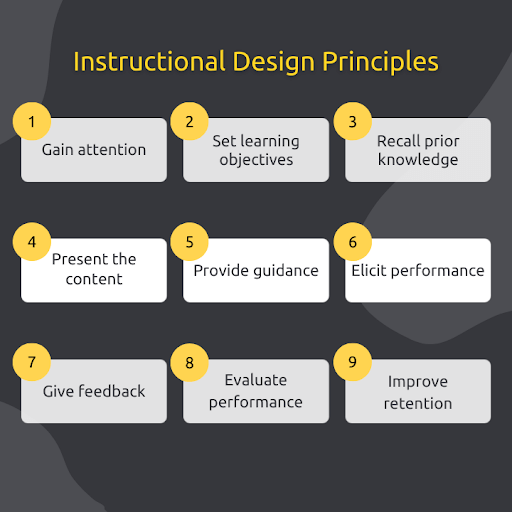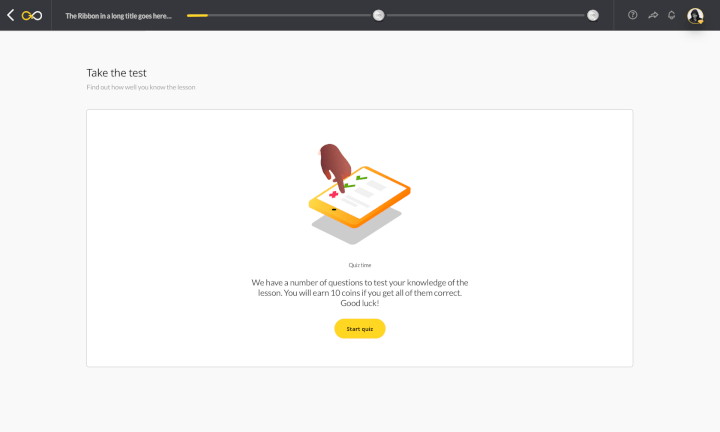Learning is hard—but so is teaching. Presenting information in a clear, concise, and digestible way is no small feat.
How can you organize the content effectively? How can you ensure that your audience stays interested and engaged (and, ideally, doesn’t fall asleep)? How can you make sure that you’re actually getting your point across?
Regardless of what or who you’re teaching, you’re bound to grapple with those questions (and more!)
Fortunately, there are a few design principles that can help you leap over those hurdles with ease and confidence.
First things first... What is instructional design?
The name instructional design sounds fancy, but it’s actually pretty self-explanatory. It’s the design of training programs, courses, and other educational initiatives.
Put simply, if you were going to teach your team something, you’d lean on instructional design to pull together those learning materials in a way that makes sense—and ultimately equips your team with the knowledge they need.
Instructional design is the result of the work and research of a number of great minds. However, much of what we know about instructional design today is credited to Robert M. Gagné, an instructional psychologist.
Gagné asserted that
To build an effective learning program, you must institute nine principles of instructional design (often referred to as instructional events).
Read more: A Beginner's Guide to Instructional Design
What are the instructional design principles?
So...what are the nine instructional design principles that Gagné identified?
We like to think that they can be categorized into three major buckets: starting the learning process, actually learning, and wrapping up the learning process. Basically, the beginning, middle, and end.
We’re sharing what you need to know about each of these principles right here.

Getting started
1. Gain attention
An effective instructional program will always start with a hook—something that brings your learners in and gets them excited about or immediately engaged in the material that you’re presenting.
Is there a compelling video that you could share? A shocking statistic that will grip your audience? Is there some sort of group exercise or demonstration you could do?
You only get one chance to make a first impression, so make sure that the start of your learning initiative—whether it’s an elearning course or real-world training—sets the right tone and engages your learners right from the outset.
2. Set learning objectives
No matter how enticing your introduction is, it’s tough to get excited about something if you don’t understand the point, right? You want to know what the end game is.
That’s why you need to be able to point to a clear learning objective as you’re going through the design process of your learning initiative. What are you hoping that your learners walk away with? What are you aiming to teach them?
Maybe your objective is to familiarize them with a new piece of software that they’ll be using. Or, perhaps you want them to know how to fill out your new expense reports.
Whatever your specific goal is, make sure that you can clearly pinpoint it—and then share it with your audience right from the start, so that you all have aligned expectations about the point of this course, training, or learning program.
3. Recall prior knowledge
Even if it feels like it, you likely aren’t starting from scratch. Your audience probably has at least some existing knowledge of the topic that you can build upon.
Gagné’s principles state that it’s important to recall that knowledge so that you can not only have more effective training (because you’re starting with a better foundation) but also so that you can tailor your learning initiatives to your audience’s current skill level.
Incorporate an open discussion about experiences that are relevant to your learning topic (for example, if you’re teaching about conflict resolution, ask them to share a recent conflict and what steps they took to resolve it), so that you can draw those parallels to real life. Or, use a short quiz to gauge the starting point of your learners.

Start teaching
4. Present the content
You’ve laid the groundwork, and now it’s time to get rolling with your actual material. With this principle, you’re actually displaying the content and teaching on the subject.
However, just because you’ve arrived at the meat and potatoes doesn’t mean you can toss creativity to the curb. Gagné’s design principles require that you organize your information in a meaningful way and get creative about how you present it.
The best way to do so is by mixing up the mediums you’re using to get your point across (rather than relying on one that will quickly become repetitive to your audience). Below are a few ideas for how you can keep your content fresh and your audience consistently engaged:
- Storytelling
- Demonstrations
- Videos
- Games and competitions
- Group exercises
The GoSkills Course Builder makes creative content presentation easy with its block-style course creation.
5. Provide guidance
Your course materials might be clear and well-structured, but that doesn’t mean that your audience won’t struggle with certain concepts or elements.
That’s why one of Gagné’s principles dictates that you should be a resource who’s ready and willing to provide guidance to your learners.
Welcome questions throughout your learning initiative—rather than saving them to the end. That way you can clear up any confusion right away, as opposed to losing those audience members. Use plenty of examples to illustrate your points. And be available after that training to answer any questions as they’re actually putting that information to use.
6. Elicit performance
Have you heard that one of the best ways to ensure that you understood someone correctly is to repeat them? Put simply, you should parrot back what they just said.
That same concept holds true in instructional design (although you don’t literally need your learners to recite your presentation or course word-for-word).
Instead, this principle is about confirming their understanding by immediately requiring them to apply that knowledge. That could mean taking a brief quiz session at the end of your learning program. Or, it could mean demonstrating what they learned in a group exercise or simulated scenario.
Information doesn’t do anybody any good if they don’t know how to put it to good use.
So, think of this step as your chance to confirm that they picked up what they needed to.
Wrapping up
7. Provide feedback
The principle of feedback falls into the last bucket, but that doesn’t mean it should only be done at the conclusion of your learning initiative.
Frequently providing feedback as your audience moves through your course or program keeps them engaged while also giving them valuable insight into how well they’re grasping the information that’s being taught.
You can sprinkle random games throughout your course. Or, stop periodically for exercises that test your audience’s knowledge. In response to that, make sure to explain what’s going well—and what needs a little more focus or attention.
Most importantly? Use those insights as you continue to move through your training. If there’s a concept that most people really aren’t grasping, it might be worth revisiting again.
Bonus: Check out our favorite elearning authoring tools.
8. Evaluate performance
Similarly, assessing performance is an important step to take at the conclusion of your learning program. This is another chance to use a quiz or assessment to not only collect their feedback but also measure their performance.
Keep in mind that this sort of assessment shouldn’t feel like a trick or surprise—it should only cover what was just discussed in your course.

9. Enhance retention
You don’t just want people to commit that information to memory so that they can spit it back to you in an assessment and then carry on with their daily lives.
Your goal is to equip them with information they can use for the foreseeable future, which means you want to make sure they retain what was just taught (or at least some of it).
Confirming their understanding will go a long way in making this happen.
But, you should also follow up with some supporting resources and other outlets they can use to continue the learning process—whether it’s an instant messaging channel where they can share other relevant tips and tricks they pick up or a regular workshop where you can keep those skills fresh.

Educate and engage with these instructional design principles
Whew! There you have it—Gagné’s nine principles of instructional design. Does this seem like a lot? Well, you might be surprised by how naturally a lot of these occur during the design and development of your own course or learning program.
Next time you’re structuring your own learning initiative, use these principles as your guide so that you can present your topic in a way that’s informative—but not the least bit boring.
Try combining the principles you've learned here with the ADDIE model of instructional design to really enhance your training initiatives.
An LMS can be a big help in checking a lot of these principles off of your list, while also ensuring your program is engaging (and even fun!). Curious? Check out the GoSkills LMS today.
Customize your training
Create your own training resources with an easy-to-use course builder.
Try it now



